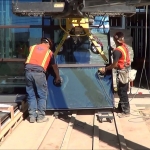| ANALYSIS: Fluctuating demand on the curtain wall sector |
| English Section Publicat de Ovidiu Stefanescu 23 Nov 2015 14:31 |
 During the recession, one of the most affected segments of the construction market was the one which involves the non-residential buildings (office buildings, shopping centers, etc.). This kind of projects are the main types of buildings addressed by the curtain wall producers. If, initially, the operators in the façade branch - which is an important component of the fenestration industry - had to adapt to the precarious situation in the field, whilst an increasing competition on the large projects sector, afterwards, as their counterparts engaged in manufacturing of windows and doors, their attention were directed mainly towards exports, providing specific services in foreign markets. Moreover, although since the end of 2014 have seen a revival in terms of volume of construction works with other destination than residential, and in 2015 the trend has accelerated, yet it is not known exactly how many of these are projects include large curtain walls. The main problem in the short and medium term is that the number of major projects, on which the specialized companies were based before the recession, continue to be fluctuating, even if the level of orders increased somewhat, which induced relative favorable perspective for the current financial year. Because later some political tensions temporarily diverted the attention out of the specific aspects of the real economy, the current hopes are that the new technocrat government will focus on effective measures to relaunch the investment (which will stimulate also the private demand), emerging from a state of inertia. Even in the current macroeconomic environment, in conjunction with the seasonal factor which typically is not favorable to carrying out construction works, there are real opportunities to ensure funding for unlocking some of the great projects which involve (re)installing curtain walls or initiate new ones. Also, gradually beneficiaries/investors give up to wait, opting for a dynamic strategy, but continues to exert further pressure on the price. This is why the demand remains floating (speaking of facades), and to compensate the lack of internal orders, the specialized companies have been forced to turn to export to avoid reorganization. During the recession, one of the most affected segments of the construction market was the one which involves the non-residential buildings (office buildings, shopping centers, etc.). This kind of projects are the main types of buildings addressed by the curtain wall producers. If, initially, the operators in the façade branch - which is an important component of the fenestration industry - had to adapt to the precarious situation in the field, whilst an increasing competition on the large projects sector, afterwards, as their counterparts engaged in manufacturing of windows and doors, their attention were directed mainly towards exports, providing specific services in foreign markets. Moreover, although since the end of 2014 have seen a revival in terms of volume of construction works with other destination than residential, and in 2015 the trend has accelerated, yet it is not known exactly how many of these are projects include large curtain walls. The main problem in the short and medium term is that the number of major projects, on which the specialized companies were based before the recession, continue to be fluctuating, even if the level of orders increased somewhat, which induced relative favorable perspective for the current financial year. Because later some political tensions temporarily diverted the attention out of the specific aspects of the real economy, the current hopes are that the new technocrat government will focus on effective measures to relaunch the investment (which will stimulate also the private demand), emerging from a state of inertia. Even in the current macroeconomic environment, in conjunction with the seasonal factor which typically is not favorable to carrying out construction works, there are real opportunities to ensure funding for unlocking some of the great projects which involve (re)installing curtain walls or initiate new ones. Also, gradually beneficiaries/investors give up to wait, opting for a dynamic strategy, but continues to exert further pressure on the price. This is why the demand remains floating (speaking of facades), and to compensate the lack of internal orders, the specialized companies have been forced to turn to export to avoid reorganization. |
ABONARE REVISTA (click aici): PROIECTE | INVESTITII | REVISTE | INDEX COMPANII
DATE DE CONTACT: Agenda Constructiilor & Fereastra - Tel/Fax: 021-336.04.16, 031-401.63.88
Stiri & Comunicate
Documente
31 mai 2023
31 mai 2023
12 aug 2022
20 mai 2022
20 mai 2022




















































